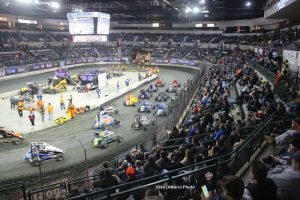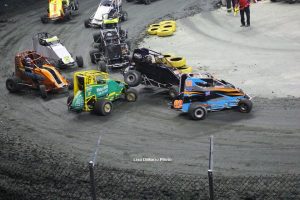
The Dirt Track is a Fickle Mistress
We spent a December Saturday at the East Coast Indoor Dirt Nationals in Trenton, NJ, recently, where we were reminded that a dirt track is a living, breathing thing, even when you dig it up and move it indoors.
 Dirt track operators across the country are all too familiar with the agonies and ecstasies of maintaining a dirt track. They fight sun, rain, cold, and heat to find that sweet spot on race day between too wet and too dry, between too dusty and too muddy, between too heavy and too slick. A good dirt track needs a “bottom” (the inside groove) and a “top” (the outer groove), ideally with a good “cushion” (a rim of accumulated dirt around the top that provides a berm against which a car can be run) and if possible a “center” groove as well.
Dirt track operators across the country are all too familiar with the agonies and ecstasies of maintaining a dirt track. They fight sun, rain, cold, and heat to find that sweet spot on race day between too wet and too dry, between too dusty and too muddy, between too heavy and too slick. A good dirt track needs a “bottom” (the inside groove) and a “top” (the outer groove), ideally with a good “cushion” (a rim of accumulated dirt around the top that provides a berm against which a car can be run) and if possible a “center” groove as well.
The best dirt track operators tend to their tracks like farmers tend to their fields, using heavy equipment, years of experience, and measured patience. They always have one eye on the weather channel and often invoke verbal supplications to a higher authority. Working alone, they may also offer words spoken to the track itself.
 Last year’s East Coast Indoor Dirt Nationals was the first, and using a combination of carefully-selected clay and expertise from regional track operators, a dirt track was constructed inside the CURE Insurance Arena in Trenton. Over several days, the material was trucked into the arena and placed on top of the concrete floor, where it was groomed into a 1/10-mile oval. The result was as close to perfection as might have been hoped: A remarkably a dust-free surface that facilitated multi-groove racing and allowed a great late-race pass for the race victory.
Last year’s East Coast Indoor Dirt Nationals was the first, and using a combination of carefully-selected clay and expertise from regional track operators, a dirt track was constructed inside the CURE Insurance Arena in Trenton. Over several days, the material was trucked into the arena and placed on top of the concrete floor, where it was groomed into a 1/10-mile oval. The result was as close to perfection as might have been hoped: A remarkably a dust-free surface that facilitated multi-groove racing and allowed a great late-race pass for the race victory.
This year, the recipe was used again and the result proved just how fickle a dirt track can be. It looked the same, but the tiniest of differences, perhaps among them the fact that the track was raced on for three days instead of two, resulted in a track that by the time of Saturday night’s big finale, had a bottom that was narrow and slow, a top that was simply too far around, and a center that offered little grip.
Lest it appear that we are finding fault with the event organizers, let us remind the reader that hindsight is 20-20 and even your author was, minutes before the main event began, predicting a great race in a very public way, during an interview with the p.a. announcer. The track was being re-groomed during the break between the last preliminary race and the feature, and we expected the track to respond to the attention it was being given.
 It didn’t.
It didn’t.
But racers are a resourceful lot, and they now faced their own challenge: Finding a way to win on the track that lay before them. Erick Rudolph, a proven winner both on the outdoor dirt tracks and in previous indoor races, started from the number one position and immediately took to the inside groove, running so tight a line through the corners that it seemed as if a person on foot might have kept pace with him. Through the entirety of the race, Rudolph never wavered from his devotion to the inner edge of the track, even when the occasional competitor drew near on the high outside groove.
One of those occasional competitors was Billy Pauch, Jr., another accomplished dirt-track racer who started the 24-car race well behind Rudolph and used the 50-lap distance of the race to make his way forward. At times using Rudolph’s low line and at times exploring the outside groove, Pauch was able to get to second position. But once in second place, there was nothing Pauch could do to wrest the lead from Rudolph. The high groove couldn’t carry him past the leader, and when at the bottom behind Rudolph there was no way to get by. Rudolph claimed the victory, Pauch settled for a well-earned second, and as is often the case in dirt-track racing, the track played a significant role in the outcome.
 Several of the best races we have ever seen have taken place on dirt tracks (we wrote about one of them here), and a key to understanding why some races are great and some are less great lies with knowing that the track itself is always a part of the puzzle – and an inconsistent part at that. The track crews face the challenge of providing a good surface, and the racers work to adjust and adapt to changeable track conditions. It’s all part of why dirt track racing is popular across the country: It’s unpredictable.
Several of the best races we have ever seen have taken place on dirt tracks (we wrote about one of them here), and a key to understanding why some races are great and some are less great lies with knowing that the track itself is always a part of the puzzle – and an inconsistent part at that. The track crews face the challenge of providing a good surface, and the racers work to adjust and adapt to changeable track conditions. It’s all part of why dirt track racing is popular across the country: It’s unpredictable. ![]()
(The East Coast Indoor Dirt Nationals features Micro-Sprints, single-seat racers powered by 600-cc Yamaha, Suzuki, and Kawasaki 4-stroke motorcycle engines. This same basic car is raced on dirt track across the United States.) ![]()
Photos by Jack Kromer and Lisa DiMario

